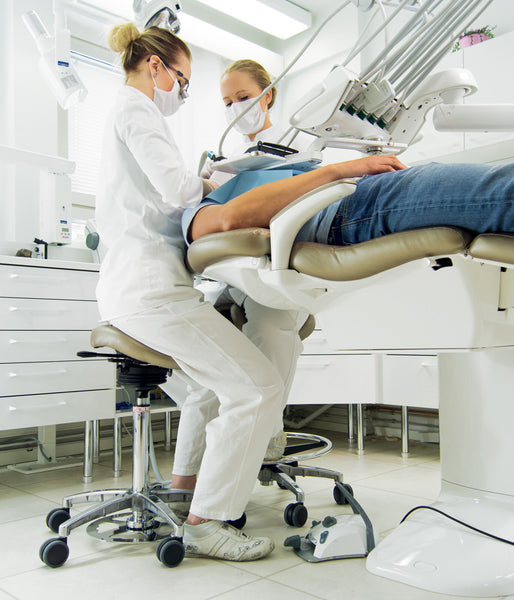Using Salli Saddle Chairs in Dentistry


Salli Saddle chairs provide a great solution to work in a good posture, as well as reducing tissue (and genital) pressure while sitting due to its split design.
Genital pressure from some saddle chairs can cause you to modify the way you sit, compromising your posture and reducing their effectiveness.
Like any tool at your disposal as a dental professional, it is important to use your chair correctly to get the best results. Here are some quick hints to help you achieve sitting happiness in a challenging environment!
- To find the best height to work in on your new saddle chair: First sit on seat, find the best tilt (if you have inclination available as on the Salli Triplefit), then lift the chair up so that your feet cannot reach the floor. Let your pelvis and your thighs hang freely and stretch for a minute - reassess the tilt while relaxing. Then lower the chair so that your feet rest firmly on the floor. Sitting too low will cause your pelvis to roll back placing unwanted pressure on your lower back.
- The beauty of Salli as a dental saddle chair is that you must work with your knees apart---this ensures a good position of your pelvis - this affords great spinal alignment and comfort for your coccyx, the gap is your friend.
- Adjust the patient chair to a correct height so that your hands are approximately 15 degrees up from the horizontal level. This way both you and the dental assistant can keep your feet under the patient chair and you do not need to bend your neck to see clearly. This is really important - your patient chair has the ability to go up and down - use it!
- Position your feet more towards your side rather than in front of you. This helps your pelvis tilt forward and your spine can align itself automatically. It also ensures your tail bone is not under pressure
- Move the foot pedal close to your foot. Don’t try to reach for it! Reaching can cause instability in your posture/alignment and creates tension in your body that inevitably leads to PAIN.
- Use clothes that are loose and in which you can move freely (pants and wide skirts). Tight skirts don’t work at all with saddle chairs.
- Vary your working angle around the patients head. Also work in a standing position every now and then if possible.
- When DAs work with a foot ring make sure they can place at least one foot flat on the ground—otherwise find a way to bring everyone down in height a little bit.
In the beginning you might feel a little discomfort, because your body has old patterns of rigidity that need to relax - holding on to these old habits can cause discomfort - similar to training aches, in your thigh and back muscles, and sitting bones as well.
The sooner you learn to relax into the chair the sooner the discomfort will disappear (It is the same phenomenon that happens with intensive training or trying a new sport.) When the adaptation period is over, the chair feels very comfortable and easy to use.
Once you adapt there is no going back to a regular style chair.







